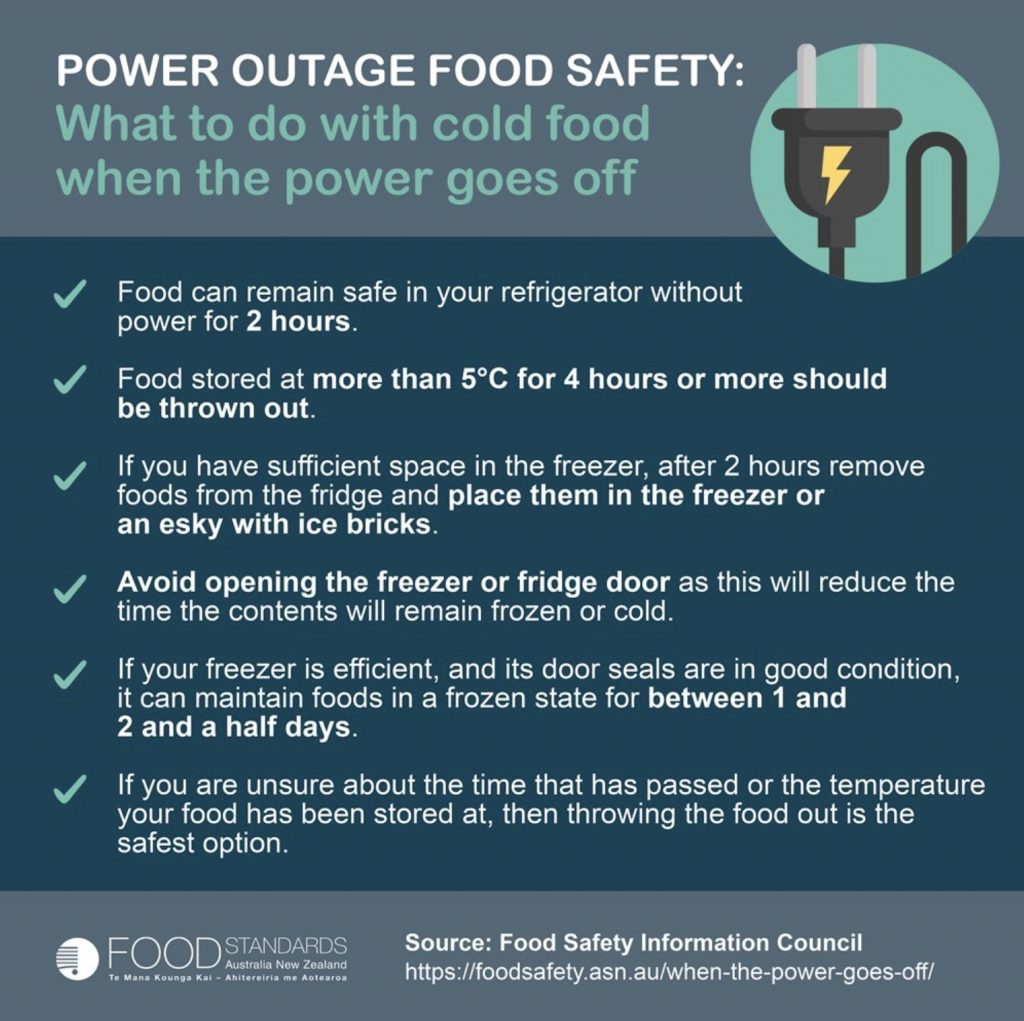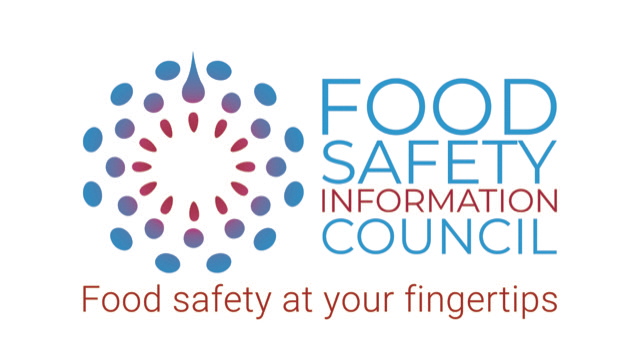
Modern refrigeration systems maintain food at safe temperatures. This helps reduce the growth of bacteria on your food which can lead to food poisoning. When there is a power outage you need to take extra measures to reduce the risk of food-related illness.
It is important to record the time the power went off. When a power cut is ongoing (that is, it lasts for more than 4 hours and there is no immediate likelihood of reconnection) food safety becomes an important issue.
Unless cold storage is available within 2 hours of a power cut, all potentially hazardous foods such as meat, poultry, seafood and ready-to-eat perishable food) that are stored in refrigerators or chillers need to be:
- placed in alternative cold storage, for example coolers with ice or ice bricks, or into the fridges of family and friend’s
- eaten immediately
- if you have a fridge thermometer and have recorded the time the power went off, eaten immediately or thrown away if the temperature rises to above 5 degrees for over 2 hours
- if you don’t have a fridge thermometer and another cold storage area is not immediately available after 2 hours.
Time and temperature are the most important measurements used to determine whether food needs to be regarded as potentially unsafe.
The ‘4 hour/2 hour rule’ for safe storage of food
The following actions are recommended for any potentially hazardous food that has been at temperatures between 5 °C and 60 °C for a total of:
- less than 2 hours – refrigerate or use immediately
- longer than 2 hours but less than 4 hours – use immediately
- 4 hours or longer – must be thrown out.
Make a note of the time the power went off. If available, use a watch and a thermometer to follow these time and temperature recommendations. Eat perishable foods first and save the dried and canned food until last.
The advice offered here refers to any or all potentially hazardous food except those normally kept at room temperature or jams, pickles and other acid foods.
Important note: If you are unsure about the time that has passed or the temperature your food has been stored at then throwing the food out is the safest option.
Planned power cuts
The day or night before power is cut off, prepare in advance to store your food safely:
- If possible, try to organise alternative refrigerated storage in advance, for example with relatives, friends or neighbours.
- Avoid buying food that needs to be frozen or refrigerated until after the power is restored
- Adjust the refrigerator to its coldest setting and remove fresh fruit and vegetables to prevent them being damaged. These items can be stored at room temperature
- Set your freezer to its coldest setting
- Place ice bricks, or freeze large blocks of ice, in the freezer for later use
- If you can, freeze some of the items from your fridge for later use. This is a very safe option and is best done well before the power cut
Sudden or unplanned power cuts
A sudden or unplanned power cut will not allow much time for you to safely store your foods. Your food will remain safe in your refrigerator for 2 hours, but there are some steps you can take:
- If you have sufficient space in the freezer, after 2 hours you should remove foods from the fridge. Place them in the freezer or esky with ice bricks.
- Do not open the freezer door unless necessary, as this will reduce the time the contents will remain frozen.
- If your freezer is efficient, and its door seals are in good condition, it can maintain foods in a frozen state for between 1 and 2 and a half days.
- Relatives, friends or neighbours may be able to provide alternative storage.
During power cuts
Food stored in refrigerators
Your food will remain safe in your refrigerator for 2 hours. If it has been more than 4 hours, throw the food out. Don’t open the fridge door during the power cut, unless necessary.
The best option is to keep the refrigerated foods as cold as possible by not opening the door unless necessary to remove food to eat or check the temperature after 2 hours. or place items in the freezer. If this is not possible:
- Remove ice bricks from the freezer and place in an esky.
- Remove all meats, poultry, dairy and potentially hazardous food (for example dips, pâté, ham, prepared and cooked food) from the refrigerator and place in an cooler with frozen bricks or gel packs.
- Salted butter, margarine and hard cheeses will remain safe at room temperature.
- Place the ice or ice bricks throughout the stored food to ensure an even temperature. Make sure the lid of the cooler has a good seal.
- If the temperature of the food stored in an cooler or refrigerator reaches more than 5 °C for less than 2 hours you should find alternative refrigeration at less than 5 °C or, if possible, freeze or use immediately.
- Food stored in a refrigerator or esky at more than 5 °C for 4 hours or more should be thrown out.
Food stored in freezers
- Freezers that are in good condition and operate at minus 15 °C or below can keep foods at safe temperatures for between 1 and 2 days. If the freezer door is kept shut, a full freezer can keep food chilled for up to 48 hours, while a half full freezer can be kept food chilled for 24 hours.
- It is important that the doors of freezers are not opened unless necessary. Opening and closing the doors will reduce the time the contents will remain at safe temperatures.
- Foods that have partly defrosted or defrosted but remain very cold (5 °C or less) can be refrozen. Remember that some food types, for example ice cream which will thaw other foods defrost. Although there is no safety issue, some foods become icy or their texture will be damaged when refrozen and may not be usable after defrosting and refreezing.
Note that while there will not be a food safety issue in refreezing defrosted foods, the quality of the food may be slighted deteriorated. You have 2 options for food that has been stored in a freezer where the temperature has reached more than 5 °C for up to 2 hours:
- Find alternative refrigeration at less than 5 °C or refreeze
- Consume immediately.
If your food has been in a freezer where the temperature has reached more than 5 °C for more than 2 hours, but less than 4 hours, it should be consumed immediately.
Food stored in a freezer for more than 4 hours at more than 5 °C should be thrown out.
Food in the process of being cooked
Throw out food that was being cooked when the power failed if cooking cannot be completed properly within 2 hours. If food is already properly cooked, eat it within 2 hours or throw it out.
Be prepared
Where possible prepare by having food on hand that doesn’t need refrigeration or heating. Foods with a long shelf life such as long life milk, bottled water or boiled water in a clean, sealed container and canned or dried goods should be part of an emergency food supply. Keep a manual can opener handy as well as a meat and fridge thermometer available to check temperatures. A torch is always a good idea to have close to hand.
If needed ensure there will be enough ready-to-use formula for infants and food for pets. If items have a use-by date, make sure you replace them periodically to keep them within these dates. See also The Pantry List for essential items you need to prestock.
Have a BBQ with a good supply of heat beads or bottled gas available for cooking.
In areas that could be affected by a flood, plan to store food well above floodwater levels.
Have coolers available and ice bricks or gel packs ready frozen to keep food cold if the power will be out.
